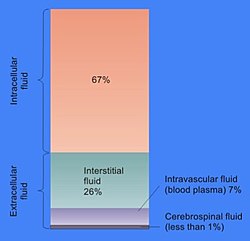
Back سائل خارج خلوي Arabic Екстрацелуларна течност Bulgarian Vanćelijska tečnost BS Líquid extracel·lular Catalan Ekstracellulærvæske Danish Extrazellularflüssigkeit German Fluido extracelular Spanish مایعات برونسلولی Persian Sreabhán eachtarcheallach Irish Fluído extracelular Galician

In cell biology, extracellular fluid (ECF) denotes all body fluid outside the cells of any multicellular organism. Total body water in healthy adults is about 50–60% (range 45 to 75%) of total body weight;[1] women and the obese typically have a lower percentage than lean men.[2] Extracellular fluid makes up about one-third of body fluid, the remaining two-thirds is intracellular fluid within cells.[3] The main component of the extracellular fluid is the interstitial fluid that surrounds cells.
Extracellular fluid is the internal environment of all multicellular animals, and in those animals with a blood circulatory system, a proportion of this fluid is blood plasma.[4] Plasma and interstitial fluid are the two components that make up at least 97% of the ECF. Lymph makes up a small percentage of the interstitial fluid.[5] The remaining small portion of the ECF includes the transcellular fluid (about 2.5%). The ECF can also be seen as having two components – plasma and lymph as a delivery system, and interstitial fluid for water and solute exchange with the cells.[6]
The extracellular fluid, in particular the interstitial fluid, constitutes the body's internal environment that bathes all of the cells in the body. The ECF composition is therefore crucial for their normal functions, and is maintained by a number of homeostatic mechanisms involving negative feedback. Homeostasis regulates, among others, the pH, sodium, potassium, and calcium concentrations in the ECF. The volume of body fluid, blood glucose, oxygen, and carbon dioxide levels are also tightly homeostatically maintained.
The volume of extracellular fluid in a young adult male of 70 kg (154 lbs) is 20% of body weight – about fourteen liters. Eleven liters are interstitial fluid and the remaining three liters are plasma.[7]
- ^ Chumlea, W. Cameron; Guo, Shumei S.; Zeller, Christine M.; Reo, Nicholas V.; Siervogel, Roger M. (1999-07-01). "Total body water data for white adults 18 to 64 years of age: The Fels Longitudinal Study". Kidney International. 56 (1): 244–252. doi:10.1046/j.1523-1755.1999.00532.x. ISSN 0085-2538. PMID 10411699.
- ^ "Fluid Physiology: 2.1 Fluid Compartments". www.anaesthesiamcq.com. Retrieved 2019-11-28.
- ^ Tortora G (1987). Principles of anatomy and physiology (5th ed.). New York, NY: Harper and Row. p. 693. ISBN 978-0-06-350729-6.
- ^ Hillis D (2012). Principles of life. Sunderland, MA: Sinauer Associates. p. 589. ISBN 978-1-4292-5721-3.
- ^ Pocock G, Richards CD (2006). Human physiology : the basis of medicine (3rd ed.). Oxford: Oxford University Press. p. 548. ISBN 978-0-19-856878-0.
- ^ Canavan A, Arant BS (October 2009). "Diagnosis and management of dehydration in children" (PDF). American Family Physician. 80 (7): 692–6. PMID 19817339.
- ^ Hall J (2011). Guyton and Hall textbook of medical physiology (12th ed.). Philadelphia, Pa.: Saunders/Elsevier. pp. 286–287. ISBN 978-1-4160-4574-8.
© MMXXIII Rich X Search. We shall prevail. All rights reserved. Rich X Search